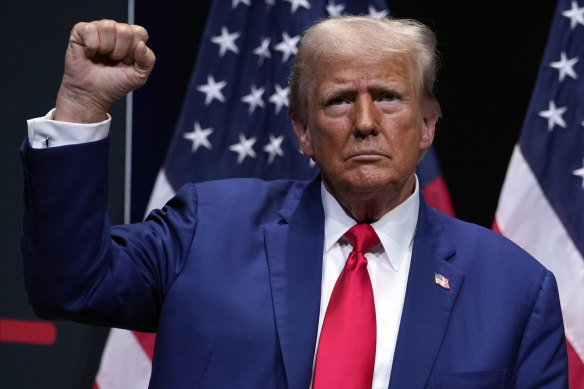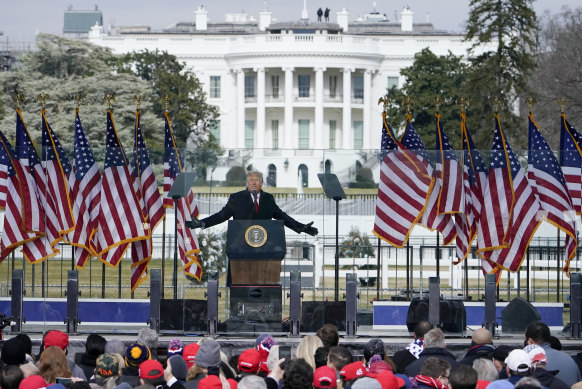This was published 5 months ago
How Trump would use soldiers against riots, crime and migrants … on US soil
By Charlie Savage, Jonathan Swan and Maggie Haberman
During the turbulent summer of 2020, then-president Donald Trump raged at his military and legal advisers, calling them “losers” for objecting to his idea of using federal troops to suppress outbreaks of violence during the nationwide protests over the police murder of George Floyd.
It wasn’t the only time Trump was talked out of using the military for domestic law enforcement – a practice that would carry profound implications for civil liberties and for the traditional constraints on federal power. He repeatedly raised the idea of using troops to secure border states, former aides have said.
In his first term in office, Trump never realised his expansive vision of using troops to enforce the law on US soil. But as he has sought a return to power, he has made clear that he intends to use the military for a range of domestic law-enforcement purposes, including patrolling the border, suppressing protests that he deems to have turned into riots and even fighting crime in big cities run by Democrats.
“In places where there is a true breakdown of the rule of law, such as the most dangerous neighbourhoods in Chicago, the next president should use every power at his disposal to restore order – and, if necessary, that includes sending in the National Guard or the troops,” Trump said in August 2022.
During his time out of power, allies of the former president have worked on policy papers to provide legal justifications for Trump’s intent to use the military to enforce the law domestically – particularly on immigration. In public, they have talked about this in the context of border states and immigrants in the country illegally. But an internal email from a group closely aligned with Trump, obtained by The New York Times, shows that, privately, the group was also exploring using troops to “stop riots” by protesters.
While governors have the latitude to use their states’ National Guards to respond to civil disorder or major disasters, a post-Civil War law called the Posse Comitatus Act generally makes it a crime to use regular federal troops for domestic policing purposes.

Republican presidential nominee Donald Trump.Credit: AP
However, an 1807 law called the Insurrection Act creates an exception to that ban. It grants presidents the emergency power to use federal troops on domestic soil to restore law and order when they believe a situation warrants it. Those federal troops could either be regular active-duty military or state National Guard soldiers whom the federal government has assumed control over.
The Insurrection Act was last invoked in 1992, when President George H.W. Bush sent troops to help suppress riots in Los Angeles following the acquittal of white police officers who had been videotaped beating a black motorist, Rodney King. In that case, however, the governor of California and the mayor of Los Angeles had asked for federal assistance to restore order.
But parts of the Insurrection Act also allow presidents to send in troops without requiring the consent of a governor.
Trump has boasted that if he returns to the White House, he will dispatch forces without any request for intervention by local authorities. At a campaign rally last year, for example, he vowed to unilaterally use federal forces to “get crime out of our cities”, specifically naming New York, Chicago, Los Angeles and San Francisco as “crime dens” that he noted were run by Democrats.
Anthony Romero, executive director of the American Civil Liberties Union, said that, as part of his group’s contingency planning for how to resist what it sees as potential risks from any second Trump administration, it is drafting lawsuits to challenge invocations of the Insurrection Act against protesters.
“It’s very likely that you will have the Trump administration trying to shut down mass protests – which I think are inevitable if they were to win – and to specifically pick fights in jurisdictions with blue-state governors and blue-state mayors,” he said.
A Trump spokesperson, Karoline Leavitt, said: “As president Trump has always said, you can’t have a country without law and order and without borders. In the event where an American community is being ravaged by violence, President Trump will use all federal law enforcement assets and work with local governments to protect law-abiding Americans.” She added that he was committed to “using every available resource to seal the border and stop the invasion of millions of illegal aliens into our country”.
Seeking a show of strength
In 2020, the videotaped killing of Floyd, a black man, by a white police officer in Minneapolis sparked racial justice protests. Peaceful demonstrations sometimes descended into rioting.
During a stormy protest in Washington DC, centred in Lafayette Square outside the White House, protesters knocked over barricades. The Secret Service whisked Trump away to a bunker underneath the White House. Attorney-General William Barr later wrote in his memoir that Trump was enraged – in part by the violence but “especially the news reports that he was taken to the bunker”. He wanted to make a show of strength as the world watched.
Because Washington is a federal enclave – not a state – it has no governor, and its National Guard reports to the Pentagon. The secretary of defence, Mark Esper, sent National Guard forces to support the Park Police and other civilian agencies protecting federal buildings.
But civilians remained in control of the response in the nation’s capital. Trump wanted to instead put the military directly in charge of suppressing violent protesters – and to use regular, active-duty troops to do it.

Then-president Donald Trump speaks at a rally before a mob invaded the US Capitol on January 6, 2021.Credit: AP
Members of his legal team drew up an order invoking the Insurrection Act in case it became necessary, according to a person with direct knowledge of what took place. But senior aides opposed such a move, and he never signed it.
Barr later wrote that he and the acting homeland security secretary had thought using regular troops was unnecessary, and that Esper and the chair of the Joint Chiefs of Staff, General Mark Milley, had “recoiled at the idea, expressing the view that regular military forces should not be used except as a last resort, and that, absent a real insurrection, the military should not be in charge but should provide support to civilian agencies”.
Troops at the border
Trump has broken with his former subordinates who raised objections to his desire to use federal troops that summer. Those who have stuck with Trump are working to ensure that a second administration would not contain politically appointed officials or lawyers who would be inclined to see it as their duty to constrain his impulses and desires – one of several reasons a second Trump presidency is likely to shatter even more norms and precedents than the first.
Most of the open discussion by people other than Trump has focused on the prospect of using troops in border states – not against American rioters or criminals, but to arrest migrants suspected of trying to enter the country illegally and better secure the border against illegal crossings.
In recent years, administrations of both parties – including President Joe Biden’s – have sometimes used the military at the border when surges of migrants have threatened to overwhelm civilian agents. But the troops have helped by taking over back-office administration and support functions.
The idea Trump and his advisers are playing with is to go beyond that by using regular troops to patrol the border and arrest people.
In an interview last year, Stephen Miller, Trump’s top immigration adviser, said Trump’s plans for an unprecedented crackdown on immigration included invoking the Insurrection Act to use troops as immigration agents.
“Insurrection – Stop Riots ** – Day 1, Easy”
The idea of using regular troops to enforce the law on domestic soil – especially away from the border – crosses a line that gives even some in the conservative think-tank world pause.
Legal and policy development work on such ideas is being handled in part by a Trump-aligned think tank called the Centre for Renewing America that is run by Russell Vought, who was Trump’s White House budget chief.
An early 2023 email from a member of the centre’s staff listed 10 agenda topics for papers that the centre planned to write on legal and policy frameworks.
The email placed each topic into one of three categories. One set involved Congress. A second involved “broader legal” issues – including “Christian nationalism” and “nullification”, the pre-Civil War idea that states should be able to negate federal laws they don’t like. The third category was “day one” ideas, meaning those whose legal frameworks were well established, and which could be put into effect by a president unilaterally.
No.4 on the list: “Insurrection – stop riots ** – Day 1, easy.”
The centre has not published any paper on invoking the Insurrection Act to use troops to suppress violent protests. But earlier this year, it published a paper on a closely related topic: invoking that law to use troops in south-west border states to enforce immigration law. The paper was co-written by Ken Cuccinelli, the acting deputy homeland security secretary in the Trump administration.
While the paper focuses on border security, most of its legal analysis applies to any situation in which a president deems the use of troops necessary to suppress lawlessness. It laid out arguments for why the Insurrection Act provides “enormous” leeway for the president to use regular troops directly to make arrests and enforce the law.
In a statement, a spokesperson for the Centre for Renewing America, Rachel Cauley, said: “Thank you for confirming that we have made it a priority to articulate that the president has the legal authority to use the military to secure the border.”
This article originally appeared in The New York Times.
Get a note directly from our foreign correspondents on what’s making headlines around the world. Sign up for our weekly What in the World newsletter.